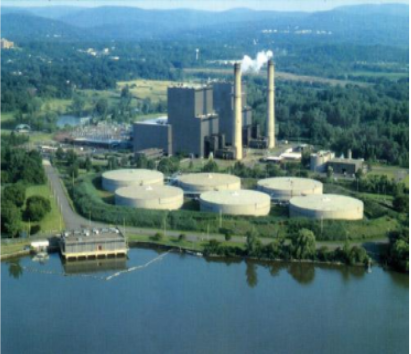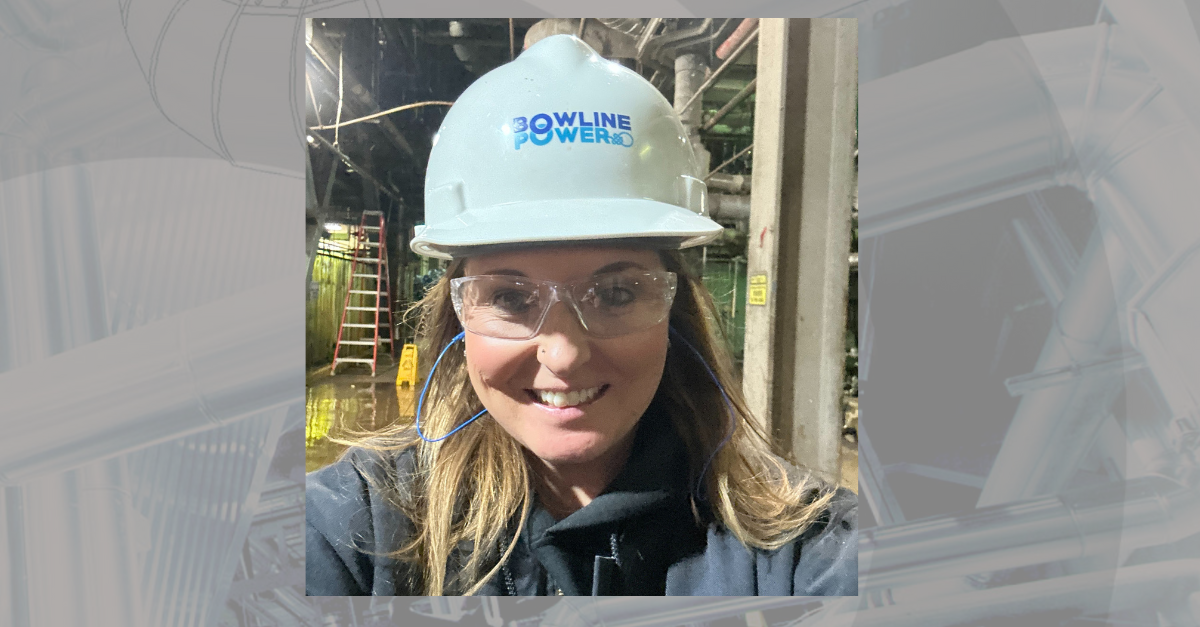By: Emily Adelman, NAES Communications Specialist
For Christine “Chrissy” Croyle, using her engineering skills is an everyday thing—quite literally. As a Senior Environmental Engineer at the Bowline Point Generating Station in New York, she ensures that operations run smoothly around the clock. But her journey into engineering started long before she set foot on the plant’s grounds.
“My dad worked here when the plant was being built in the late 1960s, early 1970s. He was here for 34 years,” Chrissy recalls. “When I graduated college and was looking for a job, he encouraged me to check Bowline out. I started in October of 2001, and here I am, 23 years later. I got into this because of my dad really.”
That sentiment carried Chrissy on throughout her time at the plant. “Some of the guys here worked for my dad, and they told me the apple didn’t fall far from the tree,” Chrissy recalls.

The Bowline Point Generating Station sits along the Hudson River in West Havershaw. It consists of two dual-fuel natural gas and oil-fired boilers and two GE steam turbine units. Chrissy works on a daily basis with the Operations and Maintenance departments for the plant.
Chrissy’s day often starts before most people’s alarms go off. “I normally come in first thing in the morning, between 6:30 and 7:00,” she says. “I turn on my computer to start monitoring the emissions from our stacks, and I check the boiler chemistry, because I also monitor that.” Once her initial checks are done, she heads out for a quick inspection of the plant. “I make sure we’re prepared for chemical deliveries and confirm that all the tanks are filled. I also check that we have the standards and reagents for our analyzers.”
While this routine sounds systematic, it’s anything but dull. Bowline generates electricity and countless things can go haywire at a moment’s notice.
“Every day is a little bit of everything; it’s never really the same day twice,” Chrissy explains. “You have to use your technical skills to get through whatever comes up.”
Sometimes, those technical skills require getting out of bed in the middle of the night. She recalls a recent 3:56 a.m. wake-up call: “I jumped into my car and headed to the plant to solve a severe problem. You never know what’s going to happen, so you just roll with the punches. It’s a new thing every day, and engineering can be used everywhere.”
Chrissy had a feeling engineering would be a good fit for her—and she was right.
“Engineering is cool, to be honest,” she says. “It’s so interesting because you can apply your thought process anywhere. Once you have an engineering-type mind, there’s really no job you can’t do.”
Though she didn’t expect to follow her father’s footsteps to the same plant, Chrissy firmly believes she belongs there. “Never in a million years did I think I would end up where my father worked, but as it ends up, I don’t belong anywhere else like I belong in this industry.”
Chrissy’s dedication to the job shows how vital engineers are to keeping facilities running. Yet, while she feels so at home in this field, many women don’t share that experience, as they remain underrepresented in engineering.
Despite making up nearly half of the nation’s total workforce, women account for only a quarter of workers in the overall energy sector, and the numbers are even smaller in certain areas. “Being a female in a male-dominant facility has its own challenges,” Chrissy says. According to the International Renewable Energy Agency, women make up 32 percent of the renewable energy workforce, but only 22 percent in the oil and gas sector.
Chrissy is one of two women who regularly enter the plant in a 57-person facility and admits that earning respect took time.
“I started in energy when I was 22, and it took a while for people to start respecting me more. It also took me a bit to realize my worth, remember my title, and accept that folks have to respect my decisions or advice when we are faced with problems.”
As she grew into her role, Chrissy found her place in the plant’s close-knit community. “The people I work with know I am here for them and for the overall good of the facility,” she says. “They trust me to keep it going and to make sure that we all have jobs to walk into every day.”
Chrissy believes the future is bright for female engineers. “I want women and girls to know that they have the power to do this,” she says. “The sky is the limit for them.” When it comes to engineering in general, Chrissy has one message:
“Go for it. It’s a great field to be in, because technology is ever-changing. Right now, it’s what kids are learning in high school and college. The things they’re going to be doing is nothing short of incredible, so I say go for it.”
From early-morning calls to late-night troubleshooting, Chrissy’s story shows that with a curious mind and a passion for problem-solving, engineering can open doors wherever you go. And if there’s one thing she’s learned from her years as an engineer, it’s that no two days in this field are ever the same, especially for a woman determined to keep the lights on.
